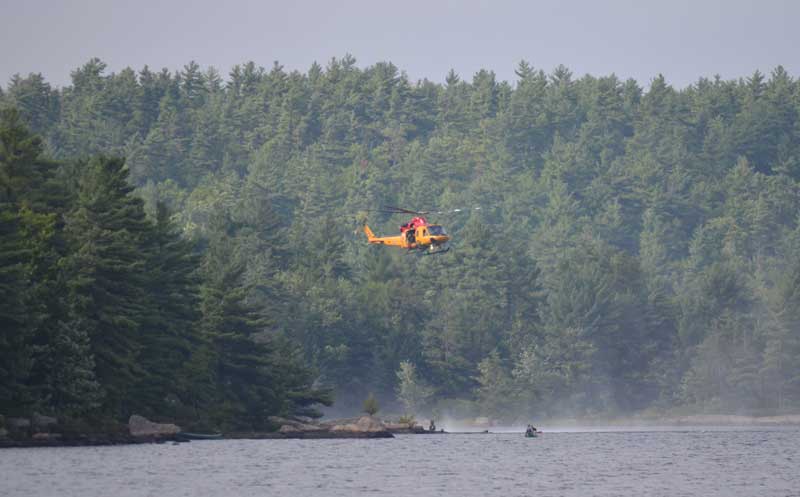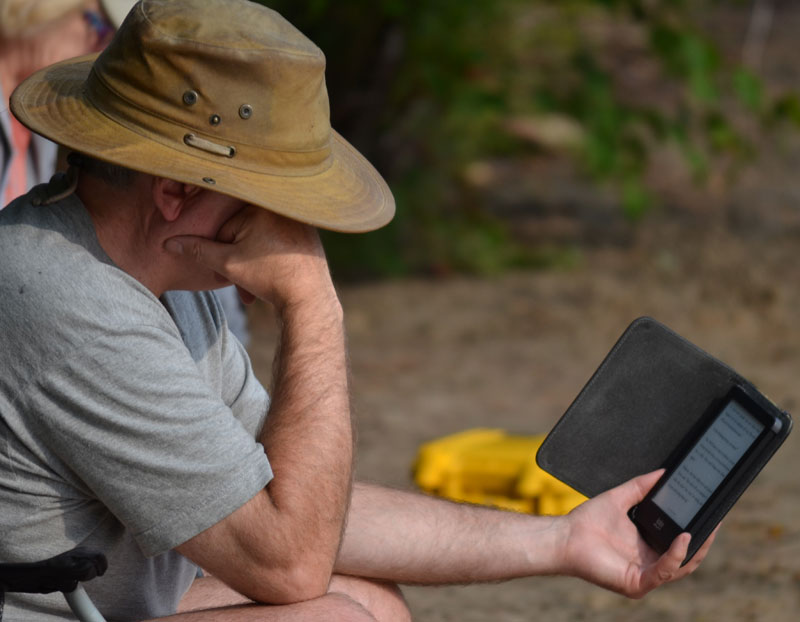
Sitting around the campfire sending emails and texting family & friends is something we never thought we would ever do – in fact, up until a few years ago, we likely would have laughed at anyone who did this. However, this has now become the norm for our group.
Phones
We are Canadian, so checking the weather on our phones is an important ritual. We all use a different weather app and the forecasts rarely match. So once we share the weather for the day, we pick the one that sounds the best and go with that.
All joking aside, we do use it to help decide when we will leave a site and if we need to hurry to put up a tarp when we arrive at a new site. There is a solo paddler in the group who relies on reports of wind speed and direction too. For the worriers in the group, it helps to know the best time to start worrying about lightning.

Some people in our group need their phones so they can tell their adult children that they are still alive and not lost and wandering in the forest. Yes, the tables have turned.
One person in our group has a very cute ritual of sending pictures to her grandchildren asking, “guess what this is”. Their answers are a riot.
Cell phones are also great in an emergency or if you have a problem with your site and need to call Ontario Parks.

Last summer we saw a helicopter land across the lake from our site and then fly off with someone who had been injured. It was amazing to watch, good to know and something none of us ever want to experience, (I am touching wood right now).
Signal Booster
Two people in our group are self-employed. They have two designated email “check in” times each day. They also travel with a signal booster (the Wilson Cradle Signal Booster with optional battery pack) for their phones. This may not be what the “work-life balance” folks would recommend, but this technology allows them to travel for a few weeks in the back-country – rather than being stuck in an office. You can check the cell coverage in the area before you go. The signal booster only works if a signal is present (e.g. 1 bar) and will typically boost it to 3 or 4 bars.
Fitbit
Two people in our group have Fitbits. This summer 16 km (10 miles) of walking was the top score – and that didn’t include all the paddling we did that day. Not bad for us old folks.
Go-Pro
New this year is the Go-Pro. We love that someone in our group is now able to capture videos of our trip. He attaches the Go-Pro to the front of the canoe, he also documents campsites and portages.
KOBO

Only one person in our group is old school and still reads paper books, the rest of us have Kobos. The Kobo Glow is perfect for reading in the tent. This year we realized that Kobo and KYBO (an old name for a Thunderbox) are very close but must not be confused!
I love my Kobo. I once portaged a hard copy of Harry Potter and the Goblet of Fire – crazy! Having many books to choose from is great, just in case the book you pack is a dud.
Back-Up Power
So what if you leave your cell phone turned on accidentally? What if your fully charged Kobo doesn’t last the entire trip? The HORROR.
Bottom line, we need our technology. That technology needs battery power. So we all pack chargers. Some of us pack two chargers.
The problem with recommending technology – is by the time we buy the product, use it for a season and then write a blog post about it, it is old technology.
So for what it’s worth – here are the battery backups we use including the old, the new, the big the tiny, the heavy, the light, the cheap and the expensive.
Our Chargers

Far Right: The solar charger with the pencil (a Solio Bolt) is very old in the world of technology – 5 years, but it’s cool. It folds up small but it is a bit delicate. The pencil is brilliant because the shadow helps you gauge the direction of the sun. It does one full charge of a phone or e-reader. Once you use it you can recharge it – however you need sunshine and you need to be at a campsite for a full day. You also need to remember to move it with the sun. Nice to have but not as handy or powerful as the new options.
The small silver tube is a RAVPower Luster Mini. This tiny charger is about 3 years old. A very lightweight option that will charge a phone twice. We love it. However, it does not seem to do a good job charging a Fitbit (the Fitbit doesn’t draw enough power, so the charger shuts off).
The Levin water and dirt resistant solar panel charger – the flat yellow solar charge – is very light, durable and can be snapped to the outside of your pack. It has lots of power and will charge a phone a few times. Nice thing about this one is that if you have sunshine you can recharge it on your trip. It recharges quickly.
The EC Technology portable Charger (red and black) worked well and it has the capacity to charge both fit-bits and phones. The only complaints: it’s big and heavy.
The green charger is the Digipower Re-Fuel PowerBank bought specifically for charging the Go-Pro. No complaints about this charger.
The ETON Weather Radio is a combination crank/solar radio and charger. It is rare that the radio is used but the crank option for charging is nice.
Finally, for the camera we just have a second battery packed.
Of course, you will need to pack the cables to connect your device to the charger – a lesson learned.
Overkill perhaps?
We got talking about the battery back-ups on the trip and realized we had enough power to stay a month or more.
However, a battery backup is one of those things that we tend not to think about …until we need it. We take at least 2 battery backups on every trip.

